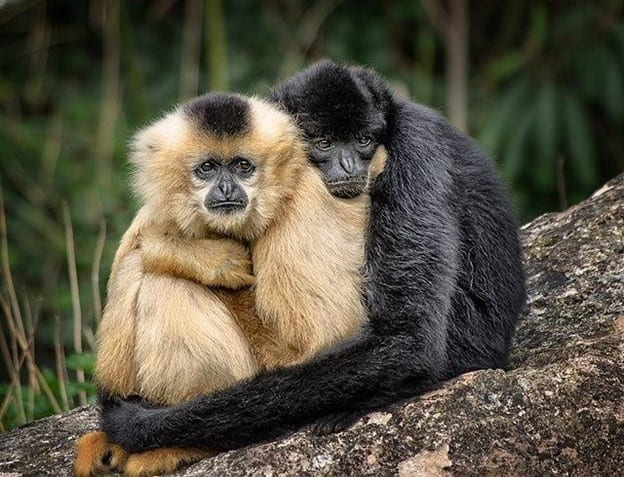Elizabeth (Shuxuan) Li ’25, Biological Sciences, 22F

Image credit: Dirk Rabe/Pixabay, CC-0
One day at the San Diego Zoo, an old male bonobo named Kakowet suddenly began screaming and frantically waving his arms at the zookeepers. After noticing Kakowet’s odd behavior, the keepers checked his surroundings to find several young bonobos stuck in a two-meter-deep moat filling up with water. The zookeepers rescued all but one ape, who was pulled out by Kakowet himself (de Waal, 1997). Kakowet’s behavior is certainly emotional and helpful, but is it enough to be called empathy?
In the past two decades, biologists have started to question whether empathy—the ability to understand another’s perspective and share their emotions—is uniquely human. The most basic level of empathy is emotional contagion, such as when human babies cry upon hearing the wails of other infants. This ability is present at birth for humans but also exists in young apes, who throw temper tantrums to make their mothers more distressed and thus pay more attention to them (Potegal, 2000). The second level of empathy is sympathetic concern, which appears around two years old in humans when toddlers try to console someone in distress. Apes also readily display this quality, such as when they wrap an arm around another member who lost in a fight (de Waal & van Roosmalen, 1979). Kakowet above has demonstrated emotional contagion by sharing the distress of the young bonobos stuck in a moat, as well as sympathetic concern in his attempt to help them.
However, scientists disagree on whether great apes possess the most advanced layer of empathy, empathic perspective-taking, which develops in humans after four years old. It first requires understanding that one’s own needs can be different from someone else’s, then thinking from that other person’s perspective, all while being emotionally involved. One empathy model by primatologist Frans de Waal (2008) proposes that great apes have all three levels of empathy. On the other hand, another model by biologists Sonja Koski and Elisabeth Sterck (2010) posits that apes do not have empathic perspective-taking, only reaching the equivalent of a human two-year-old’s empathy.
According to the first model, great apes can form a mental understanding of the specific situation where a member is in need, then adapt their behavior accordingly (de Waal, 2008). In doing so, they display the ability to distinguish their own view from someone else’s, as well as the ability to think from the other’s perspective. For example, Kakowet must have put himself in the young apes’ viewpoint to realize that they were too small to escape from the moat. He then acted distressed toward the zookeepers because he understood that they were the best ones to call for help. This targeted helping demonstrates Kakowet’s empathic perspective-taking as a chimpanzee.
However, Koski and Sterck’s model outlines that great apes’ helping behavior cannot prove the existence of full perspective-taking. Specifically, they may confuse another ape’s mental state with their own: even though Kakowet himself is not in any danger, he becomes frantic like the young bonobos. Koski and Sterck would say he is simply exhibiting emotional contagion, which is only the first level of empathy. In a similar situation, most human adults would act calmer than Kakowet. Other behaviors in apes, such as tending to another’s wounds or reconciling after a conflict, also do not necessarily require perspective-taking. In this sense, apes have not reached a level of empathy comparable to a human adult (Koski and Sterck, 2010). By diving deeper into the mental states of great apes, Koski and Sterck effectively modify de Waal’s old model.
What do these findings reveal about how empathy evolved? Given that humans and great apes share the first two levels of empathy, it is likely that their last common ancestor already had considerable abilities to socialize with others. Despite not being able to engage in full perspective-taking, their sympathetic concern—in combination with emotional contagion—would have helped them reproduce and thrive. For humans, perspective-taking in empathy likely evolved alongside the intricate social rules and hierarchies (Radzvilavicius et al., 2019). In addition, the development of language may have boosted the uniquely human ability for complex reasoning and empathic perspective-taking (Hodges et al., 2018).
Due to the lack of consensus on the experimental paradigms with high internal validity, fittle to no studies have directly investigated how great apes mentally process their acts of empathy (Koski and Sterck, 2010). Does empathic perspective-taking depend on a specific region exclusive to humans? Can the differences between human and ape empathy be traced back to anatomical variations in the brain? Future research could utilize brain scanning techniques to investigate the neural underpinnings of empathy.
References
de Waal, F. B. M. (2008). Putting the altruism back into altruism: The evolution of empathy. Annual Review of Psychology, 59(1), 279–300. https://doi.org/10.1146/annurev.psych.59.103006.093625
de Waal, F. B. M. & Lanting, F. (1998). Bonobo: The forgotten ape. University of California Press.
de Waal, F. B. M. & van Roosmalen, A. (1979). Reconciliation and consolation among chimpanzees. Behavioral Ecology and Sociobiology, 5, 55–66. https://doi.org/10.1007/BF00302695
Hodges, T. S., McTigue, E., Wright, K. L., Franks, A. D., & Matthews, S. D. (2018). Transacting with characters: Teaching children perspective taking with authentic literature. Journal of Research in Childhood Education, 32(3), 343–362. https://doi.org/10.1080/02568543.2018.1464529
Koski, S. E., & Sterck, E. H. M. (2010). Empathic chimpanzees: A proposal of the levels of emotional and cognitive processing in chimpanzee empathy. European Journal of Developmental Psychology, 7(1), 38–66. https://doi.org/10.1080/17405620902986991
Potegal, M. (2000). Post-tantrum affiliation with parents: The ontogeny of reconciliation. In F. Aureli & F. B. M. deWaal (Eds.), Natural Conflict Resolution (pp. 253–55). University of California Press.
Radzvilavicius, A. L., Stewart, A. J., & Plotkin, J. B. (2019). Evolution of empathetic moral evaluation. eLife, 8, e44269. https://doi.org/10.7554/eLife.44269
Leave a Reply